It happened again last night. Almost exactly as before.
Category: Food & Drink
Half An Ale
Continuing on the saga of my expanding gut, I was amused by this little thought from James May:

…and ordinarily, his sentiment would be correct. The correct measure is indeed the pint:

However, I have learnt a few things about this pint business. I tend to prefer my beer in said quantities, as evidenced by this pic of my breakfast beer in Edinburgh:

(Explanation: I had arisen from my hoggish slumber too late to be served breakfast, and the pub hadn’t yet started serving their lunch menu. I was in dire need of some sustenance but my knowledge of local brews was scanty, hence my selection of Tennant’s, the Edinburgh lager, which is absolutely dreadful. No wonder the Jocks are always fighting each other if that’s what they have to drink. I didn’t even finish that glass.)
Anyway, my normal choice of ale taken in pint units is somewhat compromised by the stiff DWI/DUI laws they have Over Here. If I’m walking (e.g. in Edinburgh) or being driven (e.g. to Blenheim), I can freely imbibe from pint glasses, and I have. But if I’m driving, then I have to drink in smaller quantities, e.g. this half-pint of local brew Exmoor (ugh) taken in Salisbury’s Haunch of Venison pub:

(I know, a half-pint looks ridiculous in my giant paw. Whatever.)
You might think that this is counter-productive, in that I would just drink more half-pints to achieve the desired state of inebriation, but actually (and this has been scientifically timed by The Englishman), I tend to drink a full pint (especially of 6X) in about the same time it takes me to drink a half-pint — ergo, I end up drinking half the normal quantity, and thus is P.C. Plod kept off my fat, beer-loving Texas ass.

Call me Mr. Responsible.
(And for those who are about to get all scoldy on me, don’t bother. Like so many of my writings on suchlike topics, this post should be taken with a ton of salt.)
Scotch
I’m on my way Up North to Scottishland today and don’t have time to post something current. By pure coincidence, however, a Longtime Reader asked me to rerun my old treatise on Scotch whiskies, which seems appropriate; so here it is, from March 2006, and as you may imagine, not much has changed since then:
I drink Scotch in three ways:
1. Single malts (sipping). Neat, no ice, with a glass of water consumed on alternate sips. This has less to do with style than it does with my frigging gout. I refuse to dilute the lovely stuff in my mouth, but I don’t mind diluting it in the stomach. My favorite single malts are typically from the Speyside region, and I’ll drink pretty much any single malt from those distilleries, but my absolute favorite is The Macallan 25-year-old, with Glenmorangie 10-yr-old as my “everyday” choice. For a “change”, I’ll drink The Dalmore 15-yr-old, which like Glenmorangie is a Highland malt.
Also in the cabinet right now are all the aforementioned, plus Glenfiddich 18-yr-old and Talisker 10-yr-old, for those with different tastes to mine. When Mr. FM comes to visit, I usually lay in a few bottles of Laphroiag, his favorite.
2. Blended (thirst quenching, or at parties). J&B, ice and water — and only J&B. Forget even offering me anything else. No J&B, and Kim drinks something else altogether, like gin. I actually dilute my J&B quite substantially — that gout thing again — and this also allows me to drink for longer periods of time before intoxication sets in.
3. As an after-dinner liqueur. Here I prefer the smoky, peatier singles like Laphroiag or Talisker, because I’m only going to drink one, and I can take my time in the drinking of it.
I’m not a Scotch snob, by the way, even though the above may make me sound like one. My tastes and favorites have come after some fairly extensive errrr trial and experimentation, and like in many areas of my life, I see no reason to change something with which I’m comfortable, and which has come about after considerable experience. I’ve tried most of the major single malts available internationally, and a couple available only in Scotland, but I’ve come to settle on the above because, well, I love their taste.
The wonderful thing about Scotch in general, and single malts in particular, is that it doesn’t matter how you drink it: that distinctive taste will always shine through. (However, I pretty much draw the line at drinking single malt with, say, Diet Coke, because that’s just barbaric — and once you mix any Scotch with Coke, the subtle differences between brands and types pretty much disappear, making the choice of a single malt under those circumstances just pretentious. But hey, if that’s how you want to drink that 40-yr-old Talisker…)
Just be aware that adding water to a single malt doesn’t just dilute the taste, it may change it completely. I find that this is especially true of some Highland malts. Some people happen upon such a taste, and thereafter prefer to drink their favorite single that way. Your call.
Still on the subject of taste, some say that coastal distilleries’ malts are different from those made by inland distilleries because of the salty sea air. I can’t taste it, myself, but I’m not a seasoned Scotch drinker, really.
Finally, it’s a common mistake to assume that the older the malt, the better the whisky. Some malts taste better in their “rawer” state — the malt becomes more bland as it ages — whereas others need the time to “mature” into smoothness. It’s all about your taste and preferences.
———————————————————————————-
Afterthought: It occurred to me that not everyone might be familiar with the Scotch thing, incredible as that may seem. So, for the benefit of anyone who might be interested in pursuing Scotch as a career (as so many have), here are a few pointers.
Single malts are the exclusive product of one distillery, made from barley. They will be bottled and sold as such, or else sold to other distillers to be blended with other malt- and grain whiskies (in closely-guarded secret and “proprietary” recipes) to produce “blended” Scotches such as J&B, Haig, White Horse, Bell’s, Cutty Sark and so on.
Blended malts are malts from different distilleries, sometimes called “vatted” malt. (The wonderfully-named “Sheep Dip” is a blended malt. Also, if the brand contains the words “Pride of”, or “Poit”, chances are it’s a blended malt.)
Proprietary (blended) Scotches are also broken into blended grain (grains from other distilleries) and blended Scotch (malts and grains from different distilleries). The actual number of distilleries used can be large. J&B, for example, uses the product from forty distilleries (and almost none from Islay, which is why it’s one of the smoothest Scotches on the market). Johnny Walker Red contains malts from 35 distilleries, and grains from 5 others.
As a rule of thumb, the higher the malt proportion (30%+) in the blend, the more expensive the Scotch. The most expensive (sometimes called premium) blends are at least 40% malt (eg. Johnny Walker Black, Chivas Regal). The “premium” can also be a factor not of the malt/grain mix, but of the number of malts used — the lower the number of malts in a brand, the more expensive it will be.
Single-grain Scotch whisky is rare (Black Barrel and Loch Lomond being the most famous).
(For all the info on Scotch whisky brands you’re ever likely to need, go here.)
The age of a single malt is denoted by the time it spent maturing in its cask: once bottled, it ceases to age altogether. If you see “single cask” on a single malt’s label, it means it came from one cask exclusively and was not mixed with whisky from other casks within the same distillery. Usually, this variant is hideously expensive, for not much more flavor — we’re well up the curve of diminishing returns, here.
Now for some pointers on the distilleries and their brands. The list is by no means complete (there are dozens of distilleries in Scotland — here’s a map), but I have actually tried all the ones I’ve listed.
The malts differ by region (sometimes by even smaller geographic differences) because of the different waters used, and in the distilling processes. I’ve made a few generalizations, however, just to give people an idea.
One last note: when you see a “The” before a single malt’s name, it’s not generally an affectation. Sometimes, the name is an area, not just an actual distillery (eg. Glenlivet), and “The” is usually added to denote either that it’s a single malt, or that it comes from the distillery of that name.
Speyside whiskies have a smoother taste, lighter flavor and softer aroma than most other Scotches. They are distilled, as the name suggests, in distilleries which are found along the River Spey on the northeast side of Scotland. Some of those distilleries (there are at least twenty major ones) are: Knockando, Glenlivet, Aberlour, Balvenie, Glenfarclas and Macallan.
Island/Islay whiskies come from the islands on the west- and north coasts of Scotland. Typically, they are much heavier, more aromatic, peatier-flavored whiskies, and some of the distilleries are very well-known: Laphroiag (la-froy-yag, from Islay), Talisker (Skye), Ardbeg (Islay), Highland Park (Orkney) and Bowmore (Islay).
Highland whiskies come from the north of Scotland (sometimes split into northern and southern Highlands). They tend to be darker than the Speyside malts, but not as peaty as the Island ones. Brands include such names as Dalwhinnie, Glen Ord, Dalmore, and Glenmorangie.
Lowland whiskies come from points around the Edinburgh – Glasgow axis, and there are really only two major ones: Rosebank and Glenkinchie (which is the main ingredient of Dimple Haig). I’ve tried Rosebank and didn’t really like it that much, but others (not put off by the “Lowland” appellation) swear by it.
Some factoids:
- Glenmorangie is the #1-selling single malt in Scotland.
- Glenlivet is the #1-selling single malt in the world.
- Glenfarclas is the strongest “production” single malt sold.
- The Famous Grouse is the most popular Scotch in Scotland (it’s blended, not a single).
- Johnny Walker Red (also a blend) is the most popular Scotch in the world.
- Johnny Walker Black (also a blend) is the most popular “premium” Scotch in the world.
- Chivas Regal (also a premium blend) is the most overrated Scotch in the world (okay, that’s just my opinion — OMD).
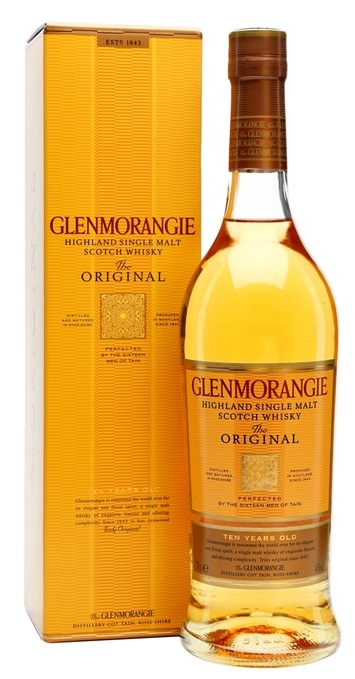
Feel free to add your comments and opinions in the regular place. Remember that taste in anything is highly personal, so no flame wars, please.
Now: on to Edinburgh.
Filling The Old Pie-Hole
One of my childhood comfort foods was the venerable (to Brits) steak ‘n kidney pie (my Murkin Readers can pause here for regurgitation purposes). Basically no larger than a fistful, it’s as advertised: pieces of steak and kidney smothered in gravy, all encapsulated in flaky pastry. As a starving boarding school pupil, it saved me from death on many an occasion when purchased from the school “tuck” shop during First Break (recess).
Most takeout places in Britishland serve these things hot, and they are pretty much a staple snack dish, along with chicken pies, pork pies, Cornish pasties (too much veg., not enough meat) and variants such as steak ‘n potato and steak ‘n onion.
However, if you’re looking for something to eat at home, i.e. something that can be bought at a supermarket, then pickings are slim; for reasons which escape me, the supermarket pies are almost all dreadful regardless of store name — Tesco, Sainsbury and even Waitrose have nothing to brag about when it comes to pies.
I thought all was lost until only a few days ago, when I discovered this magnificent item in the fridge at Sainsbury, of all places:
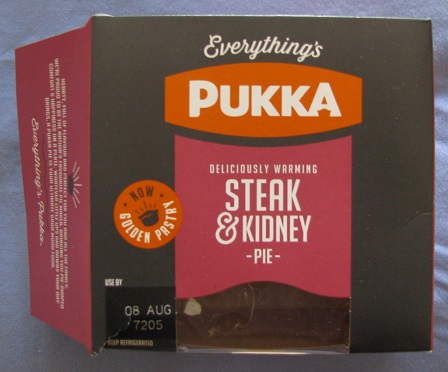
(“Pukka” is a derivative of an Indian word which means “the real thing” — and is it ever.)
Pukka makes other pies, but I don’t know which or how many, because I only had eyes for this type. I bought one, and took it home without any high expectations — but oh joy, was I ever wrong!
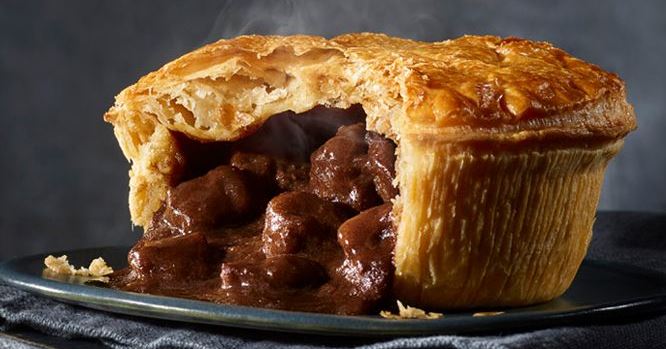
Large pieces of tender meat (no gristle), lovely savory gravy and crispy pastry, warmed in the Aga for only a few minutes: if I’d bought half a dozen I’d have eaten them all in one sitting. The Cook at FM Towers also likes them, and tells me that their other offerings are likewise splendid, so there you have it.
This has been a Public Service Announcement from Kim, and will help anyone traveling to Britishland hereafter. No need to thank me, it’s all part of the service.
Comfort Food
I’ve put on weight in the month or so that I’ve been Over Here, mostly because I’ve been enjoying the foods of my childhood (South Africa, a onetime British colony, had a partial-Brit cuisine). Yup: we’re talking sausage rolls, steak ‘n kidney pies, porridge, fish ‘n chips, Full English breakfasts and of course, the occasional chocolate bar (Fry’s Turkish Delight) not readily available in Murka.
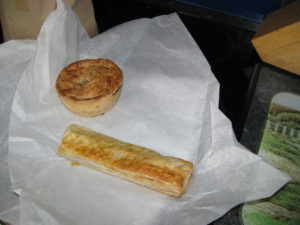
Then there’s been Wadworth 6x beer, which was not a childhood comfort food, but is definitely my adult one.
And speaking of comfort food, I’ve rediscovered the excellence of Southern Comfort as an evening aperitif. Southern Comfort was my bedside tipple of choice back when I was a professional musician (Cliff Notes: rock musician, in my early twenties, during the 1970s — of course I had a favorite bedside tipple). The best thing about Southern Comfort (Suthies, as we used to call it) is that I don’t need ice — in fact, I prefer it at room temperature which, as any fule kno, is cooler in Britishland than in Texas.
Of course, I was shocked to discover that during my long layoff from Suthies that the manufacturer had gone and changed the label from its elegant antebellum design to something more “modern” that is, well, terrible.
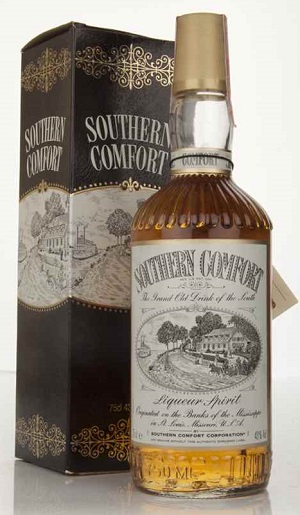
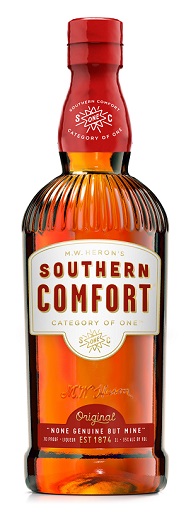
In fact, when searching for Southern Comfort on the liquor store shelves, I missed it completely because I was looking for the bottle on the left when in fact the disgusting new one was right in front of me. Worse yet, the pathetic little new cap means that you can no longer use the long gold cap of old as a shot-glass. If I can somehow find an old bottle in decent condition, I’m going to use it as a decanter.
And of course they’ve added a whole slew of new variants — “ginger”, “lemon” and so on, none of which I have any intention of trying.
I hate change.
I know: Southern Comfort is less of a whiskey than it is a liqueur. I don’t care about the designation, I only care about the taste, which is lovely. Also, it enables me to more or less keep up with the drinking rate of Mr. Free Market and The Englishman, which would cause even accomplished booze hounds like Dylan Thomas or Peter O’Toole to fall over.
And it’s an excellent accompaniment to a late-night bacon buttie — yet another comfort food of my childhood:
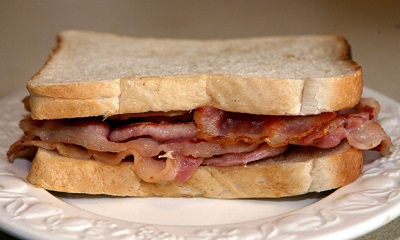
I’m gonna need three airline seats to carry my fat ass back to Dallas…
Dinner
…last night, before heading off for yet another piece of Friday Night Unpleasantness at the King’s Arms with The Englishman:
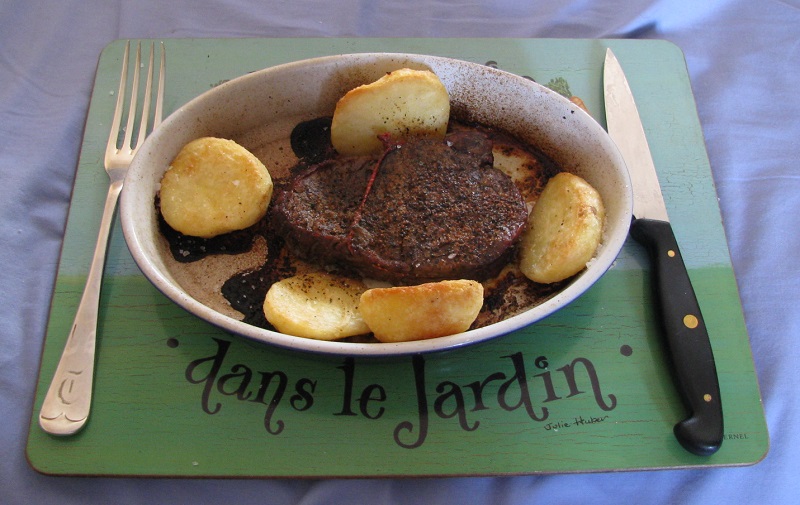
When I say I’m a “meat-and-potatoes” man, this is what I mean. A decent filet spiced with Salt Lick Rub (imported from the great state of Texas), and potatoes roasted in goose fat. It took 35 minutes in the Aga to create it.
In case you’re wondering, I had Free Market Towers to myself last night; Mrs. FM was off sailing, Mr. FM was doing Capitalist Things in (I think) the Far East somewhere, and the staff had the night off to recover from the Friday Floggings.
Food was courtesy of Waitrose. If I had one of these emporia near my house, I’d weigh 500lbs in a month.
